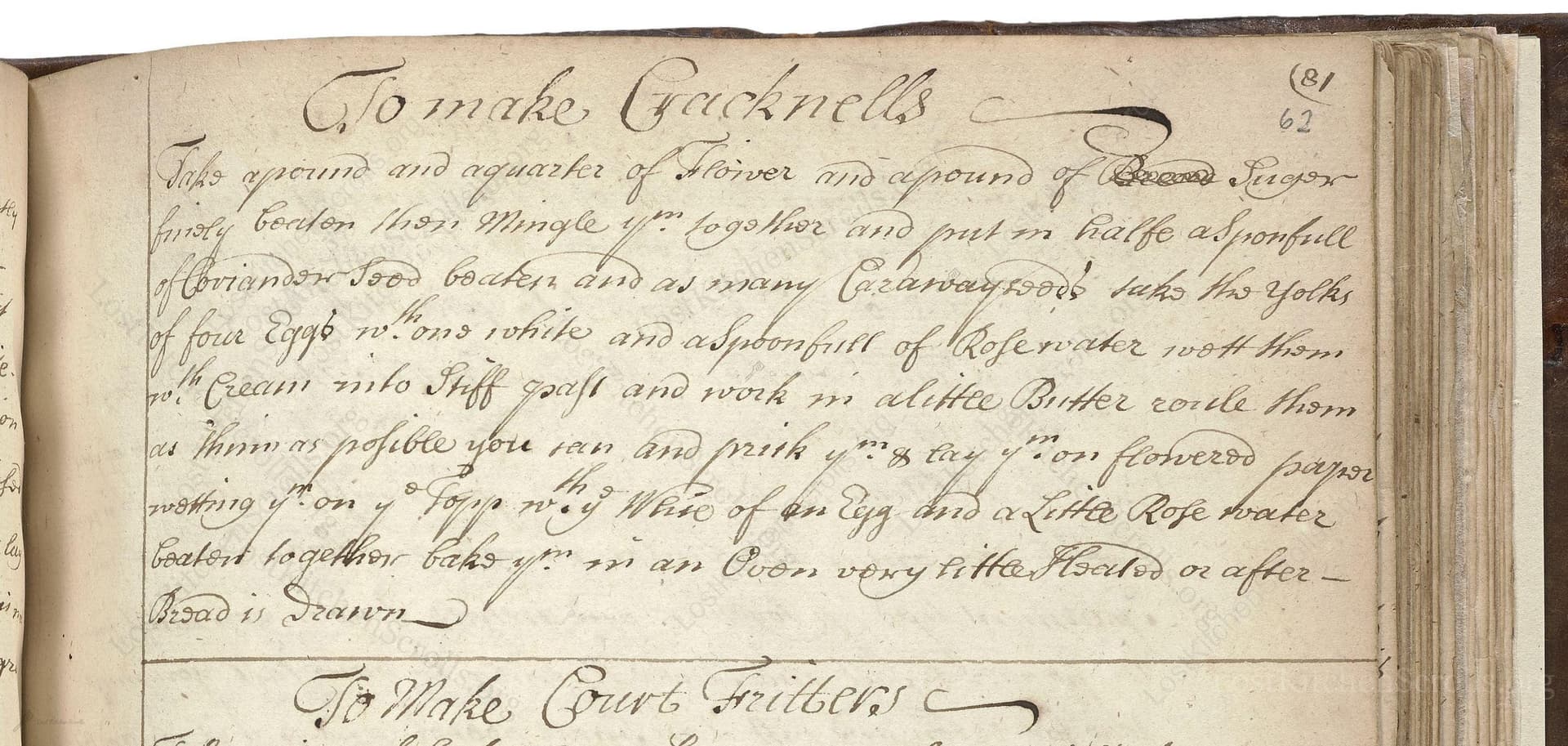To Make Cracknells
From the treasured pages of Cookbook of Grace Blome, Kent
Written by Grace Randolph

To Make Cracknells
"Take a pound and a quarter of flower and a pound of Browne Suger finely beaten then Mingle ym together put in halfe a spoonfull of Coriander seed beaten and as many Caraway seeds take the yolks of four Eggs w.th one white and a spoonfull of Rosewater wott them w.th Cream into Stiff paist and work in a little Butter role them as thinn as posibile you can and prik ym & stay ym on flowered paper wetting ym on ye topp w.th ye White of an Egg and a Little Rose water beaten together bake ym in an Oven very little heated or after Bread is Drawn."
Note on the Original Text
Seventeenth-century recipes were written for an audience comfortable with imprecise measures and interpreted experience—no oven temperatures or times, and measurement by handfuls, spoons, and judgement. Spelling was beautifully erratic (e.g. 'flower' for 'flour', 'ym' for 'them', 'wott' for 'wet', 'paist' for 'paste'). Directions are brief, lacking times and clear divisions between steps, expecting that the reader understood the rhythms of the kitchen.

Title
Cookbook of Grace Blome, Kent (1697)
You can also click the book image above to peruse the original tome
Writer
Grace Randolph
Era
1697
Publisher
Unknown
Background
A delightful glimpse into late 17th-century kitchens, this culinary collection by Grace Randolph tempts taste buds with refined recipes and elegant flavors fit for a well-to-do English household. Journey through a banquet of historic treats and timeless techniques!
Kindly made available by
Folger Shakespeare Library
This Cracknell recipe appears in the late seventeenth-century household cookbook attributed to Grace Randolph, dated 1697. Cracknells were a type of crisp, spiced biscuit or 'bisket', beloved for their aromatic snap and delicate shape. Such recipes reflect the English gentry’s growing taste for sugar, spices, and exotic imports like rosewater in the 1600s. The taste for spiced, crisp pastries reflected both trade connections and culinary showmanship in early modern elite households.

Cooks in the 1690s would have used large earthenware or wooden bowls for mixing, a pestle and mortar to finely beat the sugar and spices, and wooden rolling pins to achieve the dough’s wafer-thinness. Cracknells were baked on sheets of thick, floured paper (or ovenstones if available) inside the residual heat of a bread oven, after the loaves were drawn.
Prep Time
20 mins
Cook Time
20 mins
Servings
24
We've done our best to adapt this historical recipe for modern kitchens, but some details may still need refinement. We warmly welcome feedback from fellow cooks and culinary historians — your insights support the entire community!
Ingredients
- 20 oz plain flour
- 1 lb (16 oz) dark (brown) sugar, finely ground
- 1.5 tsp ground coriander seeds
- 1.5 tsp caraway seeds
- 4 egg yolks
- 1 egg white (plus extra for glazing)
- 1 tbsp (0.5 fl oz) rosewater (plus extra for glazing)
- 5 fl oz double (heavy) cream
- 2 oz unsalted butter
Instructions
- To recreate historic 'Cracknells,' start by mixing 20 oz of plain flour with 1 lb (16 oz) of finely ground dark (brown) sugar.
- Add 1.5 teaspoons of ground coriander seeds and 1.5 teaspoons of caraway seeds.
- In a separate bowl, whisk 4 egg yolks with 1 egg white and 1 tablespoon (about 0.5 fl oz) of rosewater.
- Combine this egg mixture with the dry ingredients and add approximately 5 fl oz of double (heavy) cream, mixing until you achieve a stiff dough.
- Work in about 2 oz of unsalted butter.
- Roll the dough as thinly as possible, prick all over with a fork, and place on baking parchment dusted with flour.
- Brush the tops with a mixture of 1 egg white and 1 teaspoon of rosewater.
- Bake at 320°F (fan 285°F) in a low oven, just until pale golden and crisp, for 12-20 minutes depending on thickness—ideally after bread has been removed, when the oven is cooling.
Estimated Calories
140 per serving
Cooking Estimates
It takes about 20 minutes to prepare the dough and gather ingredients. Baking takes 12 to 20 minutes, depending on how thin you roll the dough. This recipe makes about 24 cracknells, and each one has about 140 calories.
As noted above, we have made our best effort to translate and adapt this historical recipe for modern kitchens, taking into account ingredients nowadays, cooking techniques, measurements, and so on. However, historical recipes often contain assumptions that require interpretation.
We'd love for anyone to help improve these adaptations. Community contributions are highly welcome. If you have suggestions, corrections, or cooking tips based on your experience with this recipe, please share them below.
Join the Discussion
Rate This Recipe

Den Bockfisch In Einer Fleisch Suppen Zu Kochen
This recipe hails from a German manuscript cookbook compiled in 1696, a time whe...

Die Grieß Nudlen Zumachen
This recipe comes from a rather mysterious manuscript cookbook, penned anonymous...

Ein Boudain
This recipe comes from an anonymous German-language manuscript cookbook from 169...

Ein Gesaltzen Citroni
This recipe, dating from 1696, comes from an extensive anonymous German cookbook...
Browse our complete collection of time-honored recipes



